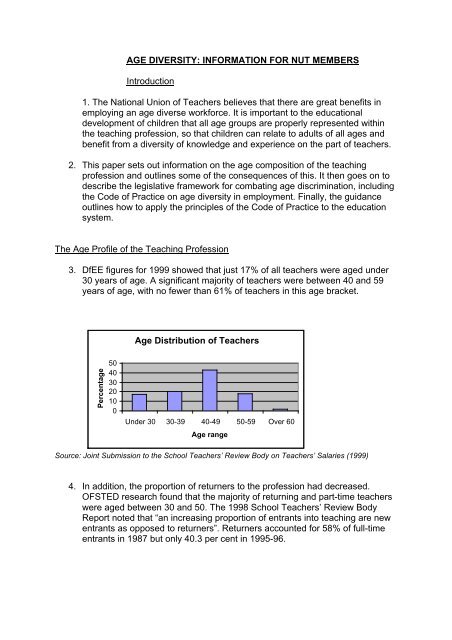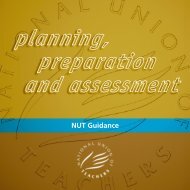AGE DIVERSITY: INFORMATION FOR NUT MEMBERS Introduction ...
AGE DIVERSITY: INFORMATION FOR NUT MEMBERS Introduction ...
AGE DIVERSITY: INFORMATION FOR NUT MEMBERS Introduction ...
You also want an ePaper? Increase the reach of your titles
YUMPU automatically turns print PDFs into web optimized ePapers that Google loves.
<strong>AGE</strong> <strong>DIVERSITY</strong>: <strong>IN<strong>FOR</strong>MATION</strong> <strong>FOR</strong> <strong>NUT</strong> <strong>MEMBERS</strong><br />
<strong>Introduction</strong><br />
1. The National Union of Teachers believes that there are great benefits in<br />
employing an age diverse workforce. It is important to the educational<br />
development of children that all age groups are properly represented within<br />
the teaching profession, so that children can relate to adults of all ages and<br />
benefit from a diversity of knowledge and experience on the part of teachers.<br />
2. This paper sets out information on the age composition of the teaching<br />
profession and outlines some of the consequences of this. It then goes on to<br />
describe the legislative framework for combating age discrimination, including<br />
the Code of Practice on age diversity in employment. Finally, the guidance<br />
outlines how to apply the principles of the Code of Practice to the education<br />
system.<br />
The Age Profile of the Teaching Profession<br />
3. DfEE figures for 1999 showed that just 17% of all teachers were aged under<br />
30 years of age. A significant majority of teachers were between 40 and 59<br />
years of age, with no fewer than 61% of teachers in this age bracket.<br />
Age Distribution of Teachers<br />
Percentage<br />
50<br />
40<br />
30<br />
20<br />
10<br />
0<br />
Under 30 30-39 40-49 50-59 Over 60<br />
Age range<br />
Source: Joint Submission to the School Teachers’ Review Body on Teachers’ Salaries (1999)<br />
4. In addition, the proportion of returners to the profession had decreased.<br />
OFSTED research found that the majority of returning and part-time teachers<br />
were aged between 30 and 50. The 1998 School Teachers’ Review Body<br />
Report noted that “an increasing proportion of entrants into teaching are new<br />
entrants as opposed to returners”. Returners accounted for 58% of full-time<br />
entrants in 1987 but only 40.3 per cent in 1995-96.
5. If the age imbalance continues, there will be serious consequences in terms<br />
of the future composition of the teaching force and its ability to attract a range<br />
of applicants representative of society as a whole.<br />
6. With almost two-thirds of the existing cohort of teachers due to retire within<br />
the next 20 years, there will be particular problems relating to the need to fill<br />
senior posts.<br />
7. Mature entrants to the teaching profession face difficulties in securing a first<br />
teaching post. The <strong>NUT</strong> has received reports from older teachers that they<br />
are perceived as being “too expensive” and that they find it difficult to secure<br />
employment.<br />
8. One <strong>NUT</strong> member’s comment is set out below.<br />
“To date I have applied for a total of 34 posts and attended six interviews”. I have<br />
checked my letter of application with two deputy heads where I have been supply<br />
teaching. They cannot fault this and one remarked that she would be impressed<br />
to receive such a letter. However, I am 42 years of age”.<br />
Another member described how she applied for a post.<br />
“The job in question would have been challenging and demanding. This was<br />
because the department was in flux, with the head of department on maternity<br />
leave, new teaching methods being put into effect and the second in charge<br />
having retired at the end of the summer. I thought that in this case my maturity<br />
and the fact that I have had regular supply teaching since qualification might go<br />
in my favour but not so. The post went to a young 20 year old who had not yet<br />
completed her Postgraduate Certificate of Education (PGCE).”<br />
9. It is possible that current and future developments in both European and<br />
British government policy may help to combat age discrimination in both<br />
teaching and other occupations. These developments are outlined below.<br />
The Legislative Picture<br />
10. The <strong>NUT</strong> believes that the voluntary Code of Practice outlined below is a step<br />
in the right direction, but the <strong>NUT</strong> would urge the government to introduce<br />
comprehensive legislation which protects against discrimination based on<br />
age. It is the <strong>NUT</strong>’s belief that a voluntary Code of Practice will be ignored by<br />
many employers.<br />
11. Age concern state that “Older workers will still have no legal recourse if they<br />
think they have suffered age discrimination. We believe that only<br />
comprehensive equal opportunities legislation will enable victims to challenge<br />
employers effectively”.
12. A survey by Equal Opportunities Review (1999) found that almost 9 out of 10<br />
wanted the Government to legislate to put ageism on an equal footing with<br />
sex, race and disability discrimination.<br />
13. Additionally, awareness of the Code of Practice is currently low among<br />
employers and older people, perhaps due to its non-statutory status (DfEE<br />
2000). Companies surveyed had not made or did not expect their organisation<br />
to make policy changes as a result of the Code, as most believed that<br />
company policy or practice is already appropriate or that it currently met<br />
Government guidelines.<br />
14. The Employers’ Forum on Age research, carried out two weeks after the<br />
launch of the Code, found that only one-quarter of employers were fully aware<br />
of the existence of the Code. 63 per cent have no intention of changing the<br />
way their business operates regarding ageism at work.<br />
15. There is a need for primary legislation incorporating a statutory Code of<br />
Practice to which employers would be required to have regard. Such<br />
legislation could be part of a single statute, as proposed by the EOC, which<br />
would be based on the principle of a fundamental right to equal treatment.<br />
DfEE research demonstrates that most employers and employees believe<br />
that the Government had done insufficient work in the area of age<br />
discrimination (DfEE 2000).<br />
16. Two new legal developments may give stronger statutory protection against<br />
age discrimination, the Human Rights Act and Article 13 of the Amsterdam<br />
Treaty.<br />
17. from October 2000,the Human Rights Act (HRA) has effect in the UK,<br />
incorporating the European Convention on Human Rights. The HRA will<br />
require that English legislation must be framed in a way that is compatible<br />
with the relevant Convention rights, as far as it is possible to do so.<br />
18. Article 14, “Prohibition of discrimination”, is not a substantive right, but it<br />
comes into play if other rights are likely to have been infringed. The prohibition<br />
is wide and no exceptions are spelt out, therefore those who feel that they<br />
have suffered from age discrimination may be able to claim under this article,<br />
if other rights have been infringed.<br />
19. If adopted by the Council of Ministers, Article 13 of the Amsterdam Treaty<br />
provides the European Union (EU) with a legal basis to take action to combat<br />
discrimination on grounds of racial or ethnic origin, religion or belief, disability,<br />
age or sexual orientation.<br />
20. Part of the proposals to combat discrimination under Article 13 is the<br />
Employment Directive, which establishes a general framework for equal<br />
treatment in employment and occupation. If agreed by the Council of<br />
Ministers, Article 13 will mean that new legislation will be required in the UK to<br />
cover equal treatment on the grounds of age and sexual orientation.
The Benefits of Age Diversity in the Teaching Profession<br />
21. It is important to the educational development of children that all age groups<br />
are properly represented within the teaching profession, so that children can<br />
relate to adults of all ages and benefit from a diversity of knowledge and<br />
experience on the part of teachers.<br />
22.Older teachers can play an invaluable role and make significant contributions<br />
to the schools in which they work. The 1994 OFSTED report, “Teacher Supply:<br />
the work of part-time and returning teachers”, found that returning and part-time<br />
teachers, the majority of whom were female and aged between 30 and 50, were<br />
well-qualified, enthusiastic, confident and committed to teaching. The quality of<br />
work of the majority of teachers in the OFSTED sample was found to be<br />
significantly above the national average, with 90 per cent of lessons being<br />
satisfactory or better.<br />
Age Diversity in Employment: Government Code of Practice<br />
23. Government research (DfEE 2000) shows that a quarter of non working<br />
people aged 50 and over, and 48% of registered unemployed people age 50<br />
and over, felt they had suffered age discrimination in the workplace.<br />
24. Preliminary evaluation of the workings of the Code of Practice suggest that,<br />
although employers on the surface do not endorse age discrimination, those<br />
interviewed for the evaluation reported discrimination particularly in the area<br />
of recruitment, where respondents felt that their age was the key mitigating<br />
factor against them gaining employment.<br />
25. The Code of Practice is voluntary and does not require any action from<br />
employers. The non-statutory Code applies to all sectors of employment. It<br />
sets out Government guidance on appropriate best practice in this area. It<br />
covers good practice in six aspects of the employment cycle, as set out<br />
below. A key factor in ensuring the Code’s success is a genuine commitment<br />
from management to its implementation, a commitment which should be<br />
clearly communicated throughout the organization and beyond.<br />
26. The Code sets out the following broad principles for the six aspects of the<br />
employment cycle:<br />
Recruitment: Recruit on the basis of the skills and abilities needed to do the job.<br />
Selection: select on merit by focusing on application form information about skills<br />
and abilities and on performance at interview.
Promotion: base promotion on the ability or demonstrated potential to do the job.<br />
Training and Development: Encourage all employers to take advantage of relevant<br />
training opportunities.<br />
Redundancy: Base decisions on objective, job-related criteria to ensure the skills<br />
needed by the organization are retained.<br />
Retirement: ensure that retirement schemes are fairly applied, taking individual and<br />
business needs into account.<br />
Applying the Code of Practice in the Education Service: a Checklist<br />
27. The principles set out in the code of practice should be incorporated into<br />
LEAs appointment and other procedures if they are not already in operation.<br />
28. Appointments Procedures:<br />
• Job advertisements should avoid reference to age: adverts should<br />
not, for example,state that the job “would suit an NQT” or a “mature<br />
teacher”.<br />
• Other less direct references should be avoided. For example,<br />
specifying that candidates should have “recent experience” will<br />
discourage applications from women who wish to return to teaching<br />
after a career break as well as applications from newly qualified<br />
teachers.<br />
• The principles which apply to fair selection should apply equally to<br />
the promotion process, i.e. promotion should be based on the<br />
ability, or demonstrated potential, to do the job, regardless of age.<br />
• Mixed age interviewing panels should be used, to ensure that<br />
appointment decisions are not based on individual prejudices and<br />
stereotypes.<br />
• Training on appointment procedures is important for all those<br />
involved in interviewing, to make sure that only job-related<br />
questions are asked and that individual prejudices based on age<br />
are not allowed to influence the selection process.<br />
29.School Funding Schemes<br />
• Fair Funding permits LEAs to fund schools on the basis of actual,<br />
rather than average, salaries. LEAs can make provision in their funding<br />
schemes for this form of salary protection for any size of school, yet few<br />
LEAs make use of this flexibility.<br />
30.Training and development<br />
• Age should not be a barrier to training: all teachers should be entitled to<br />
participate in training, regardless of age.
31.Further Information<br />
Employers’ Forum on Age<br />
Astral House<br />
1268 London Road<br />
London SW16 4ER<br />
Tel: 020 8765 7280<br />
Fax: 020 8765 7293<br />
Email: efa@ace.org.uk<br />
http://www.efa.org.uk<br />
“Age Diversity in Employment: A Code of Practice” is available from:<br />
http://www.dfee.gov.uk/agediversity/code.htm<br />
or from<br />
DfEE Publications<br />
Sherwood House<br />
Annersley<br />
Nottingham<br />
NG15 0DJ<br />
Tel: 0845 602260<br />
Fax: 0845 6033360
















